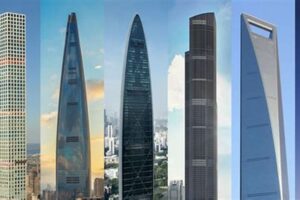The number of skyscrapers in the world is a measure of the level of development and economic growth of a country or region. Skyscrapers are typically defined as buildings that are at least 150 meters (492 feet) tall. The Council on Tall Buildings and Urban Habitat (CTBUH) is the international authority on skyscrapers and maintains a list of the world’s tallest buildings.
As of 2023, there are over 10,000 skyscrapers in the world, with the vast majority of them located in Asia. The tallest building in the world is the Burj Khalifa in Dubai, which stands at 828 meters (2,717 feet) tall. Other notable skyscrapers include the Shanghai Tower in China, the One World Trade Center in the United States, and the Petronas Towers in Malaysia.
Skyscrapers offer a number of benefits, including:
- Increased density and land use efficiency
- Reduced traffic congestion
- Improved air quality
- Enhanced economic development
- Increased tourism
However, skyscrapers also have some drawbacks, including:
- High construction and maintenance costs
- Environmental impact
- Social isolation
- Safety concerns
Overall, skyscrapers are a complex and fascinating phenomenon that have a significant impact on the built environment. They are a symbol of human ingenuity and ambition, and they continue to push the boundaries of architectural design.
1. Height
The height of a skyscraper is one of the most important factors in determining its classification. Buildings that are at least 150 meters (492 feet) tall are considered to be skyscrapers. This height requirement is important because it distinguishes skyscrapers from other types of tall buildings, such as high-rise buildings and towers.
The height of a skyscraper is also important because it affects the building’s design and construction. Skyscrapers must be designed to withstand high winds and earthquakes, and they must have efficient fire safety systems. The construction of skyscrapers is also complex and expensive, and it requires specialized engineering and materials.
The number of skyscrapers in the world has been growing rapidly in recent years. This growth is due to a number of factors, including the increasing demand for office space, the growth of the global economy, and the development of new construction technologies. The tallest skyscraper in the world is the Burj Khalifa in Dubai, which stands at 828 meters (2,717 feet) tall. Other notable skyscrapers include the Shanghai Tower in China, the One World Trade Center in the United States, and the Petronas Towers in Malaysia.
Skyscrapers have a significant impact on the built environment and can contribute to urban sprawl, traffic congestion, and air pollution. However, skyscrapers can also be designed to be sustainable, with features such as energy-efficient lighting and water-saving fixtures. Overall, the height of a skyscraper is an important factor to consider when discussing the number of skyscrapers in the world.
2. Location
The location of skyscrapers is closely tied to the number of skyscrapers in the world. Asia is home to the vast majority of skyscrapers, with China being the country with the most skyscrapers. This is due to a number of factors, including the region’s strong economic growth, urbanization, and favorable government policies.
- Economic Growth: Asia has been experiencing strong economic growth in recent decades, which has led to a corresponding increase in the demand for office space and other commercial developments. Skyscrapers are often seen as a symbol of economic prosperity and development.
- Urbanization: Asia is also experiencing rapid urbanization, with more and more people moving to cities. This has led to a greater need for housing and other urban infrastructure, including skyscrapers.
- Government Policies: Some Asian governments have implemented policies that encourage the construction of skyscrapers. For example, China has a number of policies in place that support the development of skyscrapers, including tax breaks and favorable zoning laws.
The concentration of skyscrapers in Asia is expected to continue in the coming years. This is due to the region’s continued economic growth and urbanization. Additionally, a number of Asian countries are planning to build new skyscrapers, including the Shanghai Tower in China, which is expected to be the tallest building in the world when it is completed.
3. Purpose
The purpose of skyscrapers has a significant impact on the number of skyscrapers in the world. Skyscrapers are primarily used for commercial purposes, such as offices and retail space. However, skyscrapers are also increasingly being used for residential purposes, such as apartments and condominiums. This is due to a number of factors, including the rising cost of land in urban areas and the increasing demand for luxury housing.
The number of skyscrapers used for offices is closely tied to the global economy. When the economy is strong, there is a greater demand for office space, which leads to an increase in the number of skyscrapers being built. Conversely, when the economy is weak, there is less demand for office space, which leads to a decrease in the number of skyscrapers being built.
The number of skyscrapers used for residential purposes is closely tied to the population growth in urban areas. As more and more people move to cities, there is a greater demand for housing, which leads to an increase in the number of skyscrapers being built. Additionally, the increasing popularity of luxury housing has led to a greater demand for high-rise apartments and condominiums.
The purpose of skyscrapers is an important factor to consider when discussing the number of skyscrapers in the world. The demand for office space, residential units, and hotels has a significant impact on the number of skyscrapers that are built.
4. Design
The design of skyscrapers is an important factor to consider when discussing the number of skyscrapers in the world. The design of a skyscraper can affect its height, purpose, and construction.
- Height: The design of a skyscraper can affect its height. For example, a skyscraper with a simple, rectangular design is likely to be taller than a skyscraper with a more complex, organic design.
- Purpose: The design of a skyscraper can also affect its purpose. For example, a skyscraper with a large number of windows is likely to be used for office space, while a skyscraper with a small number of windows is likely to be used for residential purposes.
- Construction: The design of a skyscraper can also affect its construction. For example, a skyscraper with a simple, rectangular design is likely to be easier to construct than a skyscraper with a more complex, organic design.
The local culture and climate can also have a significant impact on the design of skyscrapers. For example, skyscrapers in cold climates are often designed with thick walls and small windows to keep the heat in. Conversely, skyscrapers in warm climates are often designed with large windows and open spaces to let the air circulate.
The design of skyscrapers is a complex and fascinating topic. By considering the factors discussed above, we can better understand the role that design plays in the number of skyscrapers in the world.
5. Construction
The construction of skyscrapers is a complex and challenging undertaking. Skyscrapers are typically built using a steel frame, which is then clad with a variety of materials, such as glass, metal, and concrete. The construction of a skyscraper requires specialized engineering and materials, and it can be a very expensive process. For example, the construction of the Burj Khalifa, the tallest building in the world, cost over $1.5 billion.
The cost and complexity of constructing skyscrapers has a significant impact on the number of skyscrapers in the world. In many cases, the cost of constructing a skyscraper is prohibitive, and this can limit the number of skyscrapers that are built. Additionally, the complexity of constructing skyscrapers can also limit the number of skyscrapers that are built, as it can be difficult to find engineers and contractors who have the necessary skills and experience to build skyscrapers.
However, the construction of skyscrapers is also an important factor in the development of cities. Skyscrapers can provide much-needed office space and housing, and they can also be a symbol of a city’s economic prosperity. In many cases, the construction of a skyscraper can be a catalyst for further development in an area.
Overall, the construction of skyscrapers is a complex and challenging undertaking, but it is also an important factor in the development of cities. The cost and complexity of constructing skyscrapers can limit the number of skyscrapers that are built, but skyscrapers can also provide much-needed office space and housing, and they can be a symbol of a city’s economic prosperity.
6. Sustainability
The number of skyscrapers in the world is growing rapidly, and with this growth comes a growing concern about the environmental impact of these buildings. Skyscrapers can be major consumers of energy and water, and they can also contribute to air pollution and greenhouse gas emissions.
- Energy Efficiency: Skyscrapers can be designed to be energy efficient in a number of ways. For example, they can be equipped with energy-efficient lighting and appliances, and they can be designed to take advantage of natural light and ventilation.
- Water Conservation: Skyscrapers can also be designed to conserve water. For example, they can be equipped with water-saving fixtures and rainwater harvesting systems.
- Green Roofs and Facades: Green roofs and facades can help to reduce the urban heat island effect and improve air quality. They can also provide habitat for wildlife.
- Renewable Energy: Skyscrapers can be equipped with renewable energy systems, such as solar panels and wind turbines. This can help to reduce their reliance on fossil fuels and reduce their greenhouse gas emissions.
By incorporating sustainable design features into skyscrapers, we can reduce their environmental impact and make them more sustainable. This is important because skyscrapers are a major part of the built environment, and they can have a significant impact on the environment.
7. Impact
Skyscrapers have a significant impact on the built environment. They can contribute to urban sprawl, traffic congestion, and air pollution. The number of skyscrapers in the world is growing rapidly, and this growth is having a significant impact on the environment.
- Urban Sprawl: Skyscrapers can contribute to urban sprawl by increasing the density of development in urban areas. This can lead to increased traffic congestion and air pollution.
- Traffic Congestion: Skyscrapers can also contribute to traffic congestion by attracting large numbers of people to a small area. This can lead to increased traffic congestion and air pollution.
- Air Pollution: Skyscrapers can also contribute to air pollution by releasing pollutants into the air. These pollutants can include particulate matter, nitrogen oxides, and sulfur oxides.
- Green Space Reduction: The construction of skyscrapers can also lead to the reduction of green space in urban areas. This can have a negative impact on the environment and on the quality of life for residents.
The impact of skyscrapers on the built environment is a complex issue. There are both positive and negative impacts to consider. It is important to weigh the benefits of skyscrapers against the potential negative impacts before making decisions about whether or not to build them.
FAQs on the Number of Skyscrapers in the World
Skyscrapers are a prominent and iconic feature of the modern urban landscape. Their number has been steadily increasing, leading to various questions and concerns. This section aims to address some frequently asked questions about the number of skyscrapers in the world.
Question 1: How many skyscrapers are there in the world?
As of 2023, there are over 10,000 skyscrapers worldwide, with the majority located in Asia.
Question 2: Which country has the most skyscrapers?
China has the highest number of skyscrapers, with over 2,500 buildings reaching at least 150 meters in height.
Question 3: What is the tallest building in the world?
The Burj Khalifa in Dubai, United Arab Emirates, holds the title of the world’s tallest building, standing at an impressive 828 meters (2,717 feet).
Question 4: What is the average height of a skyscraper?
The average height of skyscrapers varies depending on the region and purpose. However, most skyscrapers range from 150 to 300 meters (492 to 984 feet) in height.
Question 5: What are the benefits of building skyscrapers?
Skyscrapers offer several advantages, including increased population density, improved land use efficiency, reduced traffic congestion, enhanced economic development, and increased tourism.
Question 6: What are the challenges associated with skyscrapers?
Skyscrapers also present certain challenges, such as high construction and maintenance costs, environmental impact, potential for social isolation, and safety concerns related to fires and earthquakes.
These FAQs provide a concise overview of the number of skyscrapers in the world and address common questions about their height, distribution, benefits, and challenges. Understanding these aspects helps us better grasp the role of skyscrapers in the modern built environment.
Transition to next article section:
In the following sections, we will delve into further details about the construction, design, and impact of skyscrapers on the built environment.
Tips for Understanding the Number of Skyscrapers in the World
Skyscrapers are a prominent feature of the modern urban landscape, serving as symbols of economic development and architectural innovation. Here are a few tips to enhance your understanding of the number of skyscrapers in the world:
Tip 1: Consider Regional Distribution
The number of skyscrapers is not evenly distributed across the globe. Asia, particularly China, has witnessed a significant surge in skyscraper construction, accounting for a large proportion of the world’s total. Understanding regional variations provides insights into economic growth patterns and urbanization trends.Tip 2: Explore Different Building Types
Not all skyscrapers are created equal. They vary in purpose, including commercial offices, residential apartments, and mixed-use developments. Identifying the dominant building types in a region can reveal its economic drivers and housing market dynamics.Tip 3: Analyze Height Variations
Skyscrapers come in various heights, ranging from 150 meters (492 feet) to over 800 meters (2,625 feet). Analyzing height variations offers insights into engineering capabilities, construction technologies, and the aspirations of cities to reach new heights.Tip 4: Examine Design and Architectural Styles
Skyscraper design is influenced by cultural, climatic, and aesthetic factors. Exploring different architectural styles, from modern glass facades to traditional motifs, helps appreciate the diversity and creativity in skyscraper design.Tip 5: Consider Environmental Impact
Skyscrapers can have significant environmental implications. Understanding their energy consumption, water usage, and carbon footprint is crucial for promoting sustainable urban development and mitigating the impact on the environment.
By following these tips, you can develop a more comprehensive understanding of the number of skyscrapers in the world, their regional distribution, building types, height variations, design styles, and environmental impact. This knowledge can inform urban planning, architectural discourse, and sustainable development strategies.
Transition to the article’s conclusion:
In conclusion, exploring the number of skyscrapers in the world provides valuable insights into urbanization, economic growth, architectural innovation, and environmental impact. By considering these factors, we can appreciate the significance of skyscrapers as symbols of human ambition and technological advancements, while also addressing the challenges and opportunities they present for sustainable urban development.
Conclusion
The exploration of the number of skyscrapers in the world has revealed a fascinating tapestry of urbanization, economic growth, and architectural ingenuity. Skyscrapers stand as testaments to human ambition and technological advancements, reshaping skylines and transforming urban landscapes.
As we continue to build upwards, it is imperative that we consider the environmental impact of skyscrapers and strive for sustainable urban development. By embracing innovative design solutions and implementing green building practices, we can create skyscrapers that are not only iconic but also environmentally responsible.
The future of skyscrapers holds exciting possibilities. As technology advances and architectural boundaries are pushed, we can anticipate even taller and more sustainable skyscrapers that will continue to shape the urban fabric of our world. By understanding the number of skyscrapers in the world, we gain valuable insights into the past, present, and future of urbanization and architectural innovation.







